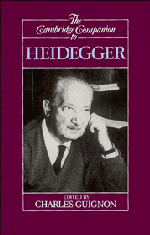Book contents
- Frontmatter
- Introduction
- 1 The question of being
- 2 Reading a life
- 3 The unity of Heidegger's thought
- 4 Intentionality and world
- 5 Time and phenomenology in Husserl and Heidegger
- 6 Heidegger and the hermeneutic turn
- 7 Death, time, history
- 8 Authenticity, moral values, and psychotherapy
- 9 Heidegger, Buddhism, and deep ecology
- 10 Heidegger and theology
- 11 Heidegger on the connection between nihilism, art, technology, and politics
- 12 Engaged agency and background in Heidegger
- 13 Wittgenstein, Heidegger, and the reification of language
- Bibliography
- Index
5 - Time and phenomenology in Husserl and Heidegger
Published online by Cambridge University Press: 28 May 2006
- Frontmatter
- Introduction
- 1 The question of being
- 2 Reading a life
- 3 The unity of Heidegger's thought
- 4 Intentionality and world
- 5 Time and phenomenology in Husserl and Heidegger
- 6 Heidegger and the hermeneutic turn
- 7 Death, time, history
- 8 Authenticity, moral values, and psychotherapy
- 9 Heidegger, Buddhism, and deep ecology
- 10 Heidegger and theology
- 11 Heidegger on the connection between nihilism, art, technology, and politics
- 12 Engaged agency and background in Heidegger
- 13 Wittgenstein, Heidegger, and the reification of language
- Bibliography
- Index
Summary
One common view of the history of twentieth-century Continental philosophy is as follows. At the beginning of the century Edmund Husserl, disturbed by what he saw as the increasing relativism and historicism of Western culture, introduced the phenomenological method as a way to ensure that philosophy would arrive at final, incontrovertible truths. Phenomenology means primarily description - description of the things presented in our experience and description of our experience of them. The phenomenological movement was heralded by Husserl's cry, “Back to the things themselves!” Because phenomenology “brackets” or suspends belief in, all metaphysical constructs in order to focus solely on what shows up as it presents itself in our experience, its findings are supposed to be apodictic, beyond all possible doubt.
According to the standard story, the early Heidegger came along and raised questions about the viability of Husserlian phenomenology by taking an “interpretive” turn. What is most important about Heidegger's hermeneutic ontology, so the story goes, is his recognition of the significance of the finitude, worldliness, and historicity of our human predicament - the recognition that our access to things is always colored and preshaped by the sense of things circulating in our historical culture. The story then concludes with poststructuralists and various postmodern thinkers detecting a nostalgia for metaphysics even in such Heideggerian concepts as worldliness, finitude, and history. Jacques Derrida especially points out that Heidegger still seems to be trapped in essentialism and totalization, twin sins of the very “metaphysics of presence” that his hermeneutic approach was supposed to displace.
- Type
- Chapter
- Information
- The Cambridge Companion to Heidegger , pp. 141 - 169Publisher: Cambridge University PressPrint publication year: 1993
- 15
- Cited by



